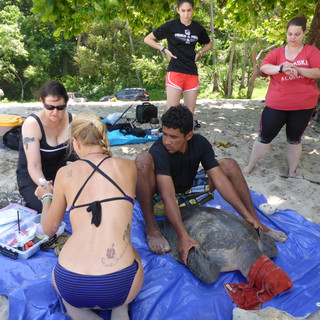First Week on the Boat
- Chris
- Jul 8, 2016
- 2 min read
The past week we have started our sampling of turtles in the water in front of Ostional. We are trying to find females and males right after they are done mating to capture both and take a variety of samples. Usually that means we wait until the male is done doing “his job” and is clinging on to the female for a while longer, trying to prevent another male approaching her and also mating with her. While the couple is in the “smoking the cigarette after” stage ;-) we approach them and transport them to our boat, where we place one animal into a car tyre while we quickly work the other one. We are trying to keep the holding time to a minimum, and practice and several helpers reduce the working time every day.
I am interested in knowing how closely related mating couples are to each other, what differences there are in morphology between females and males and how females are choosing their partner (if at all), and also how hormones are affecting mating. My colleague Brie is, furthermore, interested in how specific hormones are related to fasting and feeding (ghrelin/leptin, and vitellogenin) and the body conditions of our turtles.
The samples we are collecting are blood, tissue (epidermis), ultrasound images (to visualize the ovaries and oviducts and the subcutaneous fat layer), morphometrics, and each turtle gets equipped with metal tags in its front flippers, which contains a unique ID number and contact details of us in case they are found by somebody else.
An exciting addition this year is the installation of five radio transmitters to five females, which we are hoping to see again during the next arribada (synchronized mass nesting) in July. We are hoping to follow these females throughout their entire nesting season.
Radio transmitters have a reach of a few kilometers, and work best if nothing is obstructing the path of transmission. For the installation process the turtles are transported back to the beach and have a transmitter attached to their backs, and we have a receiver and an antenna with which we can listen and locate the females again, when they come up to breathe on the water surface and/or when they come up on the beach to lay their eggs.
The transmitters are attached with a resin/fibercloth method and it takes a while for the resin to dry. During that time a person has to carefully restrain the turtle by hand (quite an act of strength). Additionally, all our females are receiving a white paint mark (a T, for Texas A&M).
So far three transmitters have been installed and the next two will be installed next week.
Fieldwork always is a bit of an adventure and yesterday we were surprised by a heavy down-pour just at the end of the drying process of the resin, and while bringing the turtle back in the water to the location we caught her, we battled high waves and only made it back to land a few seconds before a crazy thunderstorm started….











































































Comments